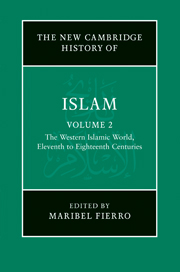Book contents
- Frontmatter
- Introduction
- PART I AL-ANDALUS AND NORTH AND WEST AFRICA (ELEVENTH TO FIFTEENTH CENTURIES)
- PART II EGYPT AND SYRIA (ELEVENTH CENTURY UNTIL THE OTTOMAN CONQUEST)
- 6 Bilād al-Shām, from the Fāṭimid conquest to the fall of the Ayyūbids (359–658/970–1260)
- 7 The Fāṭimid caliphate (358–567/969–1171) and the Ayyūbids in Egypt (567–648/1171–1250)
- 8 The Mamlūks in Egypt and Syria: the Turkish Mamlūk sultanate (648–784/1250–1382) and the Circassian Mamlūk sultanate (784–923/1382–1517)
- 9 Western Arabia and Yemen (fifth/eleventh century to the Ottoman conquest)
- PART III MUSLIM ANATOLIA AND THE OTTOMAN EMPIRE
- PART IV NORTH AND WEST AFRICA (SIXTEENTH TO EIGHTEENTH CENTURIES)
- PART V RULERS, SOLDIERS, PEASANTS, SCHOLARS AND TRADERS
- Glossary
- Bibliography
- Index
- References
8 - The Mamlūks in Egypt and Syria: the Turkish Mamlūk sultanate (648–784/1250–1382) and the Circassian Mamlūk sultanate (784–923/1382–1517)
from PART II - EGYPT AND SYRIA (ELEVENTH CENTURY UNTIL THE OTTOMAN CONQUEST)
Published online by Cambridge University Press: 28 March 2011
- Frontmatter
- Introduction
- PART I AL-ANDALUS AND NORTH AND WEST AFRICA (ELEVENTH TO FIFTEENTH CENTURIES)
- PART II EGYPT AND SYRIA (ELEVENTH CENTURY UNTIL THE OTTOMAN CONQUEST)
- 6 Bilād al-Shām, from the Fāṭimid conquest to the fall of the Ayyūbids (359–658/970–1260)
- 7 The Fāṭimid caliphate (358–567/969–1171) and the Ayyūbids in Egypt (567–648/1171–1250)
- 8 The Mamlūks in Egypt and Syria: the Turkish Mamlūk sultanate (648–784/1250–1382) and the Circassian Mamlūk sultanate (784–923/1382–1517)
- 9 Western Arabia and Yemen (fifth/eleventh century to the Ottoman conquest)
- PART III MUSLIM ANATOLIA AND THE OTTOMAN EMPIRE
- PART IV NORTH AND WEST AFRICA (SIXTEENTH TO EIGHTEENTH CENTURIES)
- PART V RULERS, SOLDIERS, PEASANTS, SCHOLARS AND TRADERS
- Glossary
- Bibliography
- Index
- References
Summary
The Turkish era of the Mamlūk sultanate
The Mamlūks’ rise to power: a decade of trial and error
The Arabic term mamlūk literally means ‘owned’ or ‘slave’, and was used for the white Turkish slaves of pagan origins, purchased from Central Asia and the Eurasian steppes by Muslim rulers to serve as soldiers in their armies. Mamlūk units formed an integral part of Muslim armies from the third/ninth century, and Mamlūk involvement in government became an increasingly familiar occurrence in the medieval Middle East. The road to absolute rule lay open before them in Egypt when the Mamlūk establishment gained military and political domination during the reign of the Ayyūbid ruler of Egypt, al-Ṣāliḥ Ayyūb (r. 637–47/1240–9).
Al-Ṣāliḥ Ayyūb’s army, including his elite bodyguard, the Baḥriyya, was mainly composed of Qipchak Turkish mamlūks. Al-Ṣāliḥ took great care to reserve most iqṭāʿs (tax revenues from land assignments) for his mamlūks and to confer the most prominent positions upon his confidants. Shajar al-Durr, al-Ṣāliḥ’s Turkish slave-girl and later his wife, was one of his regime’s stalwarts without holding any formal position in government. The common background of al-Ṣāliḥ’s mamlūks and the power they accumulated during his lifetime, coupled with the personal loyalty they felt towards him rather than to the Ayyūbid house, enabled Shajar al-Durr to run the kingdom upon his death in 647/1249, during the Crusader invasion led by King Louis IX of France, and to install his son Tūrānshāh on the throne.
- Type
- Chapter
- Information
- The New Cambridge History of Islam , pp. 237 - 284Publisher: Cambridge University PressPrint publication year: 2010
References
- 5
- Cited by

